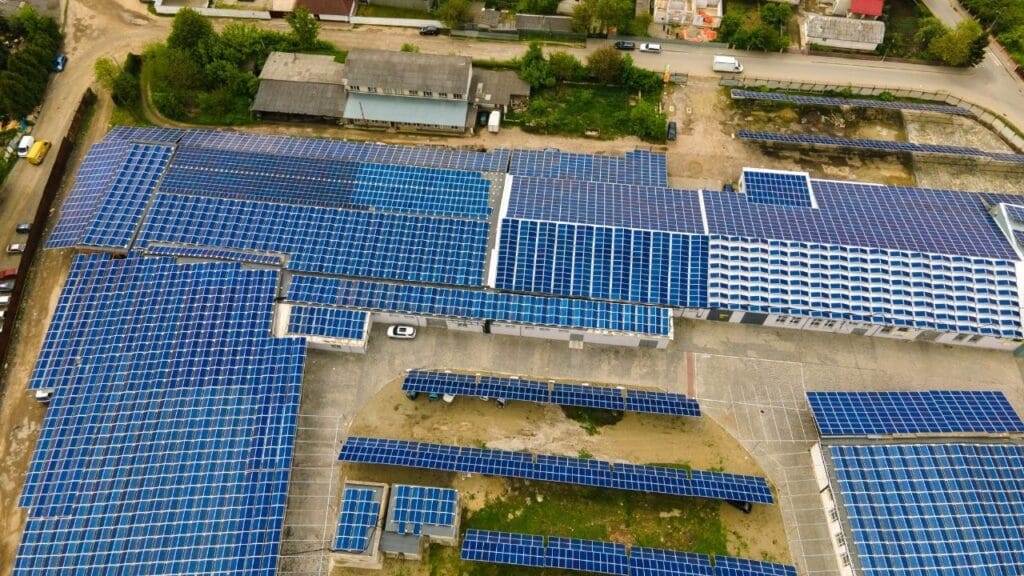Commercial Solar Panel | Installation | Features | Types
Commercial solar panels are an array of multiple photovoltaic cells that convert solar energy into electricity. Each array can be a single module or several modules, depending on the amount of power required. Commercial solar panels employ a large number of arrays to generate more electricity and provide a large amount of usable power.
Photovoltaic (PV) cells are devices that use light energy to generate electricity. They are made up of a positive layer and a negative layer that together creates an electric field. These cells are arranged in panels which make up modules, modules which make up arrays, and can be used to power creations.

Commercial solar arrays offer reliability, durability, and a larger surface area to produce more power. Commercial solar panels have been designed to have an extended life and are ideal for rental properties, as not a permanent installation.
Commercial solar panels can be installed on the top of buildings and generate enough energy to meet the building’s power needs. This is good for the environment, as it cuts down on reliance on fossil fuels and reduces greenhouse gases.
The panels help reduce the costs of electrical bills and sufficiency to the community and have no carbon emissions which has become a global concern.
How do Commercial Solar Panels work?
Commercial solar panels are pollution-free and use renewable energy from sunlight and convert it into electricity that is used to provide power for electrical loads. This electricity can be used by the building owners to reduce the overall demand on the electric utility grid, or unused electricity to the grid.
Commercial Solar Panels can be used in a variety of applications, including powering office buildings, restaurants, convenience stores and car washes. With a commercial inverter, tap into the continuous flow of electricity generated by Commercial Solar Panels, or store it for later use.

-
Solar Panel
The monocrystalline solar panel is the most popular in the market. Sun rays fall on the Solar Panel where these rays get converted into electricity through Photovoltaic cells.
-
Solar Inverter
The efficient Solar Inverter converts the DC power from the panel into AC power that can be used by the household or send it to the grid.
-
Energy Metre
With an energy metre keep track of energy usage. It will show how much energy is produced and how much is consumed at all the devices connected to the home network.
-
Utility Grid
If it produces more power than the home consumes, the surplus is fed into the power grid and credited to the electricity account.
Why Solar Panel
-
Low-Cost Power
Power is a low-cost power generation option. When the sun shines, PoweR will increase electricity supply to households and reduce power bills to zero or reduce to a minimum.
-
Renewable Energy
Renewable Energy offers a reliable source of electricity which is clean, safe, and inherently sustainable. It does not pollute or contribute to global warming through the release of harmful gases, or have potentially volatile and disruptive price fluctuations like most other energy sources.
-
Low Maintenance
Don't worry about the high maintenance costs of solar installation. Galaxy solar ensures to serve with the right maintenance after the system installation and the maintenance cost is nominal.
-
Eco-friendly
Save nature by saving the depletion of fossil fuels so it can be sustained for future generations. Solar panels are powered by sunlight and as long as there is sun in the sky they will continue to provide electricity.
Features of Commercial Solar Panels
- Commercial solar panels reduce installation costs, create more value on a building's real estate, improve power reliability, reduce harmful emissions into the atmosphere, and produce stable and predictable energy cost as a result of a solar power system.
- Work efficiently day and night with revolutionary new commercial solar panels. With these solar panels, generate enough power during the day to harness to be used at night as well.
- Commercial solar panels are the ultimate in efficiency and dependability. built to withstand all weather conditions, require very little maintenance.
- When properly installed, solar panels continue to generate energy through 20 or more years of service.
Applications of Solar Panels
- The power density of a commercial solar panel is generally much greater than those used in residential applications.
- Solar panels are used for a variety of applications, including powering homes in remote areas, providing electricity for large industrial plants and for businesses that use large amounts of electricity.
- Industrial-sized solar panels use the sun's energy to generate electricity, or to heat up liquids.
Disadvantages of solar energy
- The major disadvantage of solar energy is that it cannot generate power at night. It would be nearly impossible to store the power generated during daylight hours for use at night.
- Solar panels are used for a variety of applications, including powering homes in remote areas, providing electricity for large industrial plants and for businesses that use large amounts of electricity.Solar power is a use of energy from the sun. It's clean and renewable. But it doesn't come without some major issues like toxic and difficult to recycle materials that create solar cells or panels.
- Solar energy has the potential to provide many of the same benefits of traditional energy sources at a fraction of the cost.

